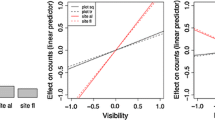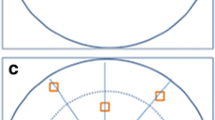Abstract
Plant censuses are known to be significantly affected by observers’ biases. In this study, we checked whether the magnitude of observer effects (defined as the % of total variance) varied with quadrat size: we expected the census repeatability (% of the total variance that is not due to measurement errors) to be higher for small quadrats than for larger ones. Variations according to quadrat size of the repeatability of species richness, Simpson equitability and reciprocal diversity indices, Ellenberg indicator values, plant cover and plant frequency were assessed using 359 censuses of vascular plants. These were carried out independently by four professional botanists during spring 2002 on the same 18 forest plots, each comprising one 400-m2 quadrat, four 4-m2 and four 2-m2 quadrats. Time expenditure was controlled for. General Linear Models using random effects only were applied to the ecological indices to estimate variance components and magnitude of the following effects (if possible): plot, quadrat, observer, plant species and two-way interactions. High repeatability was obtained for species richness and Ellenberg indicator values. Species richness and Ellenberg indicator values were generally more accurate but also more biased in large quadrats. Simpson reciprocal diversity and equitability indices were poorly repeatable (especially equitability) probably because plant cover estimates varied widely among observers, irrespective of quadrat size. Grouping small quadrats usually increased the repeatability of the variable considered (e.g. species richness, Simpson diversity, plant cover) but the number of plant species found on those pooled 16 m2 was much lower than if large plots were sampled. We therefore recommend to use large, single quadrats for forest vegetation monitoring.
Similar content being viewed by others
References
Bengtsson J (1998) Which species? What kind of diversity? Which ecosystem function? Some problems in studies of relations between biodiversity and ecosystem function. Appl Soil Ecol 10:191–199
Dobremez JF, Camaret S, Bourjot L, Ulrich E, Brêthes A, Coquillard P, Dumé G, Dupouey JL, Forgeard F, Gauberville C, Gueugnot J, Picard JF, Savoie JM, Schmitt A, Timbal J, Touffet J and Trémolières M (1997) RENECOFOR—Inventaire et interprétation de la composition floristique de 101 peuplements du réseau (Campagne 1994/1995). Office National des Forêts, Paris
Camaret S, Bourjot L, Dobremez JF (2004) Suivi de la composition floristique des placettes du réseau (1994/95–2000) et élaboration d’un programme d’assurance qualité intensif. Office National des Forêts, Paris
Ellenberg H, Weber HE, Düll R, Wirth V, Werner W and Paulißen D (1992). Zeigerwerte von Pflanzen in Mitteleuropa. Verlag Goltze, Göttingen
Graham MH and Edwards MS (2001) Statistical significance versus fit: estimating the importance of individual factors in ecological analysis of variance. Oikos 93:505–513
Helm DJ and Mead BR (2004) Reproducibility of vegetation cover estimates in south-central Alaska forests. J Veget Sci 15:33–40
Hubalek Z (2000) Measures of species diversity in ecology: an evaluation. Folia Zool 49:241–260
Hurlbert SH (1971) The nonconcept of species diversity: a critique and alternative parameters. Ecology 52:577–586
Kennedy KA, Addison PA (1987) Some considerations for the use of visual estimates of plant cover in biomonitoring. J Ecol 75:151–157
Klimeš L (2003) Scale-dependent variation in visual estimates of grassland plant cover. J Veget Sci 14:815–821
Klimeš L, Dancák M, Hájek M, Jongepierová I and Kucera T (2001) Scale-dependent biases in species counts in a grassland. J Veget Sci 12:699–704
Lepš J, Hadincová V (1992) How reliable are our vegetation analyses? J Veget Sci 3:119–124
Lessels CM, Boag PT (1987) Unrepeatable repeatabilities: a common mistake. Auk 104:116–121
Lundström S (2000) Plant cover estimate in long-term monitoring—how to assess its precision. Report 2000:8. Swedish University of Agricultural Sciences, Uppsala
Magurran AE (1988) Ecological diversity and its measurement. Princeton University Press, Princeton
McCune B, Dey JP, Peck JE, Cassell D, Heiman K, WillWolf S, Neitlich PN (1997) Repeatability of community data: species richness versus gradient scores in large-scale lichen studies. Bryologist 100:40–46
Nilsson IN, Nilsson SG (1985) Experimental estimates of census efficiency and pseudoturnover on islands: error trend and between-observer variation when recording vascular plants. J Ecol 73:65–70
Novotny V (1993) What can be inferred from species diversity indices? Coenoses 8:25–26
Pinheiro JC, Bates DM (2000) Mixed-effects models in S and S-PLUS. Springer, New York
Rameau JC, Mansion D, Dumé G, Timbal J, Lecointe A, Dupont R, Keller R (1989). Flore forestière française. Guide écologique illustré. Tome 1: Plaines et collines. Institut pour le Développement Forestier, Paris
Scott WA, Hallam CJ (2002) Assessing species misidentification rates through quality assurance of vegetation monitoring. Plant Ecol 165:101–115
Small CJ, McCarthy BC (2002) Spatial and temporal variability of herbaceous vegetation in an eastern deciduous forest. Plant Ecol 164:37–48
Sutherland WJ (1996) Ecological census techniques: a handbook. Cambridge University Press, Cambridge
Sykes JM, Horrill AD, Mountford MD (1983) Use of visual cover assessments as quantative estimators of some British woodland taxa. J Ecol 71:437–450
Tonteri T (1990). Inter-observer variation in forest vegetation cover assessments. Silva Fenn 24:189–196
Underwood AJ (1997) Experiments in ecology. Cambridge University Press, Cambridge
van der Maarel E (1979) Transformation of cover- abundance values in phytosociology and its effects on community similarity. Vegetatio 39:97–144
Acknowledgements
F. Gosselin kindly helped with statistical analyses. Four referees are acknowledged for useful comments on the manuscript. This study was supported by grant from the French Ministry of Agriculture and Forestry (Convention No. 61.45.36/01).
Author information
Authors and Affiliations
Corresponding author
Appendix 1
Appendix 1
Rights and permissions
About this article
Cite this article
Archaux, F., Bergès, L. & Chevalier, R. Are Plant Censuses Carried Out on Small Quadrats More Reliable than on Larger Ones?. Plant Ecol 188, 179–190 (2007). https://doi.org/10.1007/s11258-006-9155-y
Received:
Accepted:
Published:
Issue Date:
DOI: https://doi.org/10.1007/s11258-006-9155-y




